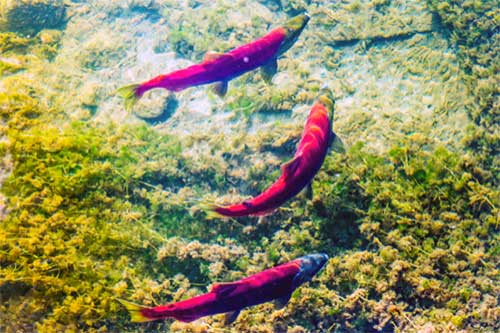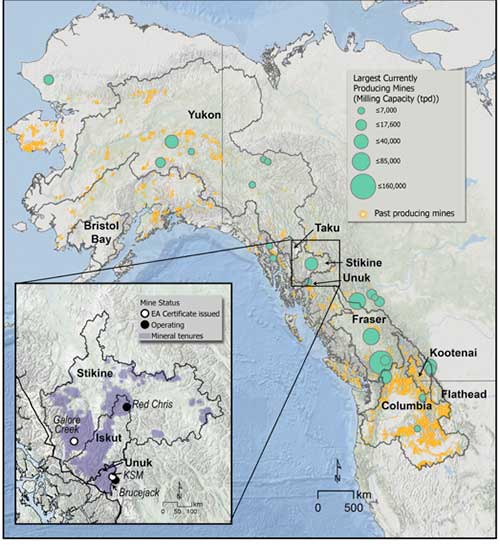Migrating sockeye salmon approach their spawning grounds on a tributary of the Copper River. |
For the study, experts integrated and reviewed information on hydrology, river ecology, aquatic toxicology, biology and mining policy. Their robust assessment maps more than 3,600 mines throughout Montana, Washington, British Columbia, the Yukon and Alaska. The size of the mines ranges from family-run placer sites to massive open-pit projects.
The study shows that, despite impact assessments intended to evaluate risk and inform mitigation, mines continue to harm salmonid-bearing watersheds through contaminants, stream channel burial and streamflow alteration. Silt suffocates eggs, and embryos may not survive contaminated groundwater. Heavy metals compromise a salmon’s sense of smell, which affects their ability to react to predators and find their way back from the ocean to spawn.
“Not all mines pose the same level of risk, but our review revealed that harm from mining can be severe and long-lasting. The extent of mining pressures on these watersheds underscores the importance of accurately assessing risk to water, fish and communities,” said Sergeant.
The paper also describes how some mining policies do not account for the breadth and length of mining impacts on the environment, or the increasing effects of climate change.
“The crux of the issue is that salmon use so much of the watershed during their life cycle. They move throughout watersheds, whereas the impact assessments of mining projects tend to be very locally focused, and they don’t sufficiently consider all of the compounding and downstream effects of mining,” said salmon biologist and CFOS faculty member Megan McPhee.
Current and past producing metal and coal mining locations |
She explained that some impact assessments don’t fully assess the infrastructure required to operate a mine, such as roads, electricity generation and water removal.
“Another thing is that most mines, after closure, have to be mitigated in perpetuity. That’s a problem because most corporations aren’t structured that way. Also, most mitigation strategies don’t take into account environmental change, including permafrost melting, and climate change-induced flooding,” said McPhee.
Moving forward, the authors highlighted four key issues that will be foundational to modern, science-based risk assessment and mitigation, beginning with understanding stressor complexity and uncertainty. Stressors include impacts such as altered hydrology and temperature, habitat modification and loss, and pollutants.
Other key issues are accounting for cumulative effects of mining activities across a mine’s life cycle, developing realistic mitigation strategies and recognizing the potential for climate change to magnify risk.
On the Web:
Science advances: Risks of mining to salmonid-bearing watersheds
This article is provided as a public service by the University of Alaska's College of Fisheries and Oceans Sciences. Alice Bailey [ ambailey2@alaska.edu ]is a science writer for the Alaska College of Fisheries and Oceans. |
Representations of fact and opinions in comments posted are solely those of the individual posters and do not represent the opinions of Sitnews.
Send a letter to the editor@sitnews.us
SitNews ©2022
Stories In The News
Ketchikan, Alaska
Articles & photographs that appear in SitNews are considered protected by copyright and may not be reprinted without written permission from and payment of any required fees to the proper freelance writers and subscription services.
E-mail your news & photos to editor@sitnews.us
Photographers choosing to submit photographs for publication to SitNews are in doing so granting their permission for publication and for archiving. SitNews does not sell photographs. All requests for purchasing a photograph will be emailed to the photographer.


